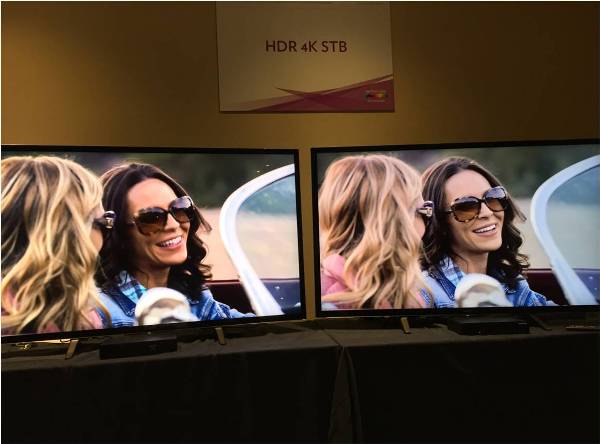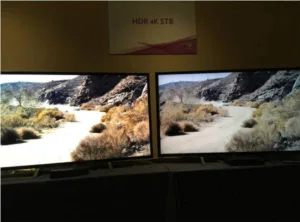Technicolor held its yearly science and research event in Jersey City, NJ. Technicolor, the technology company which focuses on the creation, distribution and storage of image related content, has about $3.5 billion in sales. About €500 million comes from licensing, with €1.6 billion coming from services for studios and content creators and €1.4 billion generated by what the company calls the ‘connected home’, which includes cable and satellite companies
Technicolor holds over 40,000 patents and adds about 2,000 new patents per year. It sees the landscape for IP-based businesses changing from a pure patent licensing model to what it calls a technology licensing model. What the company means by that is that smaller inventors of technology will find it more and more difficult to license any of their technology, while larger and established players like Technicolor are able to deal with manufacturers as they can provide complete technical solutions, rather than just a patent license.
With a total of about 14,000 employees, the company has a total of about 250 research scientists working in three research centers (France, Germany and the US).
During the event, Technicolor gives its own scientists a chance to get a glimpse of what their colleagues are working on. This year the company also allowed a few members of the press to participate and peek into the future of Technicolor. While it had a a total of over 30 demonstrations set up, only a few were shown to outsiders like the press participants, which was understandable as the others may not have been protected by patent applications yet.
HDR Tools
With high dynamic range (HDR) displays coming to market, Technicolor sees a demand for creating HDR content based on existing standard dynamic range (SDR) content. The company showed a solution that expands the existing SDR content to HDR automatically based on algorithms, but has the option for the operator to also affect the process.
UHD HDR Cable Box
Technicolor showed two identical Sony HDR TV sets side by side, one running in SDR and the other in HDR mode. The HEVC compressed content was fed to the set top boxes via a USB stick and runs almost simultaneously. The following images show the set up side by side. Just guess which TV shows the HDR content.

You are right, of course the one on the left. Just tell me how you guessed that from looking at your SDR display at a low resolution image? In real life the images were quite different and both looked very natural, with the HDR TV looking more realistic. It also demonstrates the issue with HDR content shown on a display that is not capable of displaying the full dynamic range. Images look a little over saturated and too bright. In the HDR TV you could actually see detail on the road for example. The set top box did run at 8 bit, but the final consumer version will run 10 bit and will be available later this year.
VR Tools for Content Creation
The company is also working on tools for VR content that requires a completely new approach for production tools. Technicolor created a short video for demonstration purposes shown on a Samsung Gear headset. The content creation tools needed for VR content are still at an early stage and it will take some time before it reaches the market.
Multi Media VR
Technicolor also showed a multi media version of VR, where it connected a massage pad with the headset adding another dimension to the virtual reality experience.
Light Field Camera
Based on some models of light field cameras, as well as a home built camera rig that takes the same image from different positions, the company can create a 3D map of a captured scene and is able to shift the focus plane after the scene is captured. Technicolor is working on developing a work flow around this technology, that it believes will change the way content is captured in the future. (Others, including the Fraunhofer, are working on this kind of approach (Fraunhofer IIS Does Lightfield Movie Production Test and Fraunhofer Explains its Virtual Camera Technology at IBC 2014)
Visual Dubbing
When movies are shown in different languages than they are captured in, dubbing will create a difference in lip synch. The company is proposing a technology that allows for the mouth of an actor in the movie to be moved by looking at the ‘dubber’ and extracting his lip movements. Based on 3D mapping of the face, the company then creates a version of the scene where the actor actually moves his lips in synch with the new language. Showing a scene where this technology has been applied, it was working alright but the resulting face movements left a weird feeling of “something not being right”. (That will be ‘uncanny valley’, then – Man. Ed.) The technology needs a little more tweaking before it will be used in the industry.
DNA Storage
Yes this is not referring to anything other than real DNA, as in the DNA everyone has in their body. The idea is to create synthetic DNA with specific ATCG- based sequences representing the zeros and ones in today’s digital video formats. The advantage of using DNA based storage is the long lifetime of DNA strands that can last thousands of years, compared to decades for other storage medium. The company actually showed a vial with a droplet containing 10 million DNA copies of a short video sequence (10 MB each). Technicolor is working with Harvard on this project and believes that this is a solution that can solve some of the storage capacity issues which Hollywood is running into.
The issue with DNA storage is the relative high failure rate of 5% for writing and reading. However Technicolor says that it solved this issue through a specific encoding scheme. Having 10 million copies in a droplet does not hurt either.
I also had the chance to talk to Stephane Rougeot, the deputy CEO responsible for all technology at Technicolor. He sees the overall landscape for content creation and consumption changing in coming decades, in ways that we may not even be able to foresee at the moment. VR, AR and other technologies will change the way content is envisioned and created, as the director will no longer be able to direct the viewer’s eyes to what he thinks is relevant, but there will be multitudes of story lines playing out all at the same time. It will depend on the viewer on how he will experience content and not so much on the director, as is true for today’s movie content.
Overall it was a very entertaining opportunity to see how a technology company like Technicolor prepares for the future. – NH

